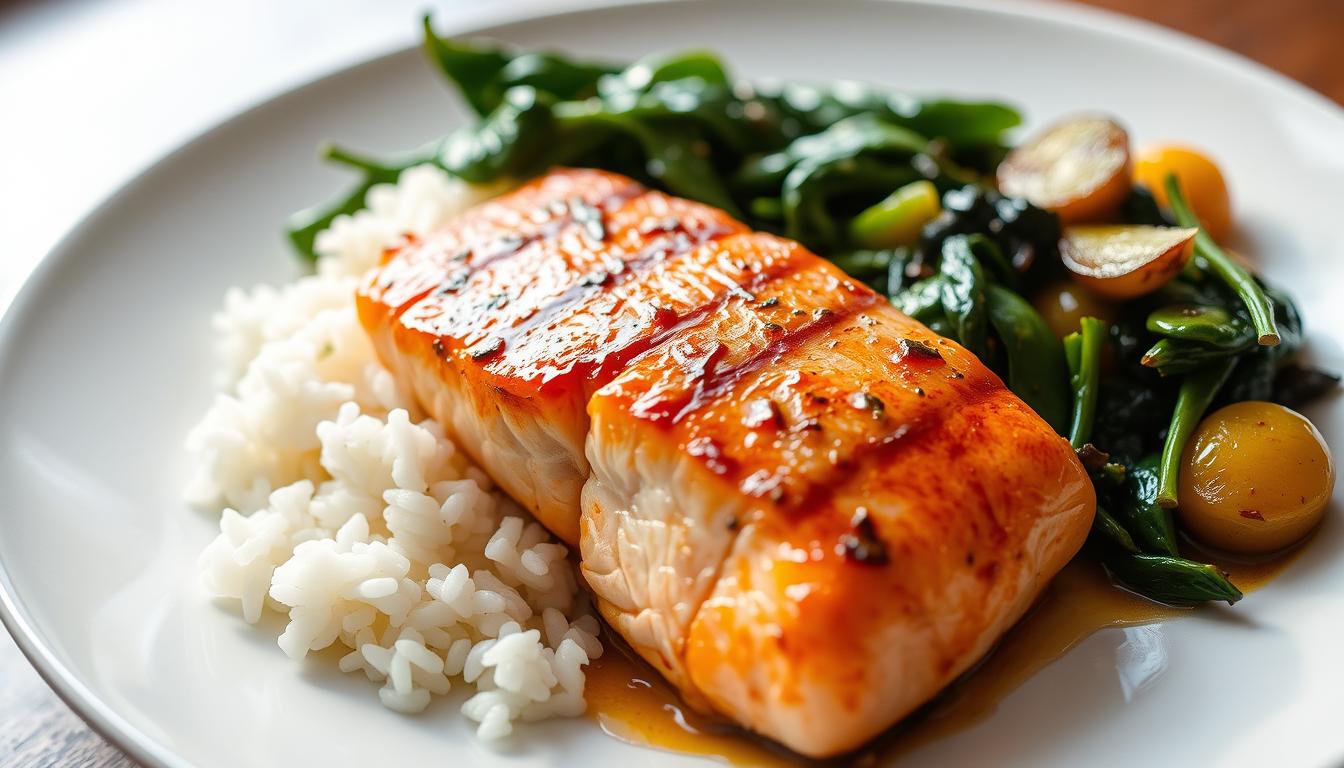Could a simple, delicious meal help manage fibromyalgia symptoms? A plate of grilled salmon, spinach, and brown rice might be the answer. This Mediterranean dish combines anti-inflammatory ingredients that could ease muscle pain, fatigue, and sleep issues.
Did you know about 4 million adults in the United States have fibromyalgia? While there’s no cure, the right diet can help manage symptoms. Foods high in omega-3s, antioxidants, and anti-inflammatory properties can offer relief.
In this article, we’ll dive into the science behind this recipe. It could be a game-changer for managing fibromyalgia symptoms. Get ready to find a tasty way to nourish your body and fight chronic pain.
Understanding Fibromyalgia and Diet
Fibromyalgia is a chronic condition that causes widespread muscle pain, fatigue, and sleep issues. There’s no cure, but diet may help manage symptoms. Research shows that certain foods can reduce pain and improve life quality.
Dietary Interventions for Fibromyalgia
Several diets have been tried to help fibromyalgia symptoms. These include low-calorie, vegetarian, and low-FODMAP diets. They aim to cut inflammation and provide essential nutrients.
A Mediterranean-style anti-inflammatory diet has shown benefits. It focuses on anti-inflammatory foods like fruits, veggies, whole grains, and healthy fats. It limits foods that cause inflammation, like processed and sugary items.
Research also links gluten consumption to worse fibromyalgia symptoms. Some people find relief by following a gluten-free diet.
By choosing the right foods, people with fibromyalgia can reduce pain and improve their life. Nutrition therapy is key to managing this complex condition.
| Tryptophan Content in 100g of Chosen Foodstuff | Taurine Content in Various Foods |
|---|---|
|
|
By following these fibromyalgia diet tips, people can manage chronic pain. Focusing on anti-inflammatory foods and nutrition therapy can greatly improve well-being.
Anti-Inflammatory Diet for Fibromyalgia
If you have fibromyalgia, an anti-inflammatory diet might change your life. Studies show that eating foods like fruits, vegetables, nuts, and herbs can help. These foods can reduce muscle pain, fatigue, and sleep issues.
Harness the Power of Anti-Inflammatory Foods
Eating anti-inflammatory foods can fight the inflammation that causes fibromyalgia symptoms. Some of the best foods include:
- Berries, full of antioxidants and flavonoids
- Avocado, rich in healthy fats and anti-inflammatory compounds
- Fatty fish, like salmon, with lots of omega-3 fatty acids
- Turmeric, a spice with strong anti-inflammatory effects
- Ginger, which can lessen inflammation and pain
- Leafy greens, like spinach and kale, full of vitamins and minerals
Choosing to eat more of these foods can help reduce your fibromyalgia symptoms. You might feel better overall. Learn more about how to add these foods to your diet at this link.
Keep in mind, an anti-inflammatory diet is not the same for everyone. It might take some time to find the right foods for you. Be patient, keep trying new recipes, and find what works best for your fibromyalgia.
Grilled Salmon with Spinach and Rice for Fibromyalgia
Living with fibromyalgia means finding meals that are tasty and good for you. The grilled salmon with spinach and rice recipe is perfect for this. It’s a fibromyalgia-friendly meal that combines ingredients that help manage symptoms.
Salmon is full of omega-3 fatty acids, which fight inflammation. These acids can help reduce pain and inflammation in fibromyalgia. Spinach is also packed with vitamins, minerals, and antioxidants that boost health.
Brown rice adds complex carbohydrates and fiber to the dish. It helps keep blood sugar stable and makes you feel full. This meal is not only tasty but also supports your body’s fight against inflammation, making it a fibromyalgia-friendly choice.
Adding this grilled salmon with spinach and rice recipe to your diet can help manage fibromyalgia symptoms. A balanced, anti-inflammatory diet is a key tool in managing this chronic condition.
Benefits of Salmon for Fibromyalgia
If you’re dealing with fibromyalgia’s chronic pain and fatigue, adding salmon to your diet could help a lot. Salmon is packed with omega-3 fatty acids. These are known for their strong anti-inflammatory effects.
Research shows that salmon’s omega-3s can cut down inflammation. This can help ease the fibromyalgia pain many people face. Salmon tackles the inflammation at its source, making it a natural way to manage symptoms and boost your health.
Salmon is also full of vitamins D and B vitamins, which are key for fibromyalgia patients. These nutrients help support your health and may help lessen symptoms.
Adding salmon to your meals is a simple yet powerful move for managing fibromyalgia. You can grill, bake, or mix it into tasty dishes. Increasing your salmon intake can be a big step towards better managing your condition.
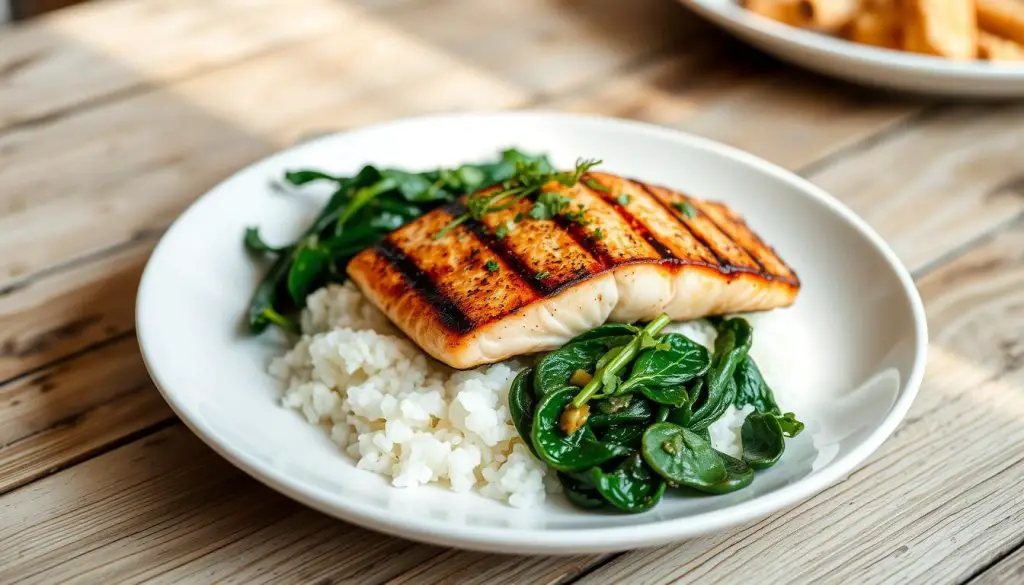
| Nutrient | Benefits for Fibromyalgia |
|---|---|
| Omega-3 Fatty Acids | Reduce inflammation and alleviate pain |
| Vitamin D | Support overall health and well-being |
| B Vitamins | Contribute to symptom reduction |
Nutrient-Dense Spinach and Rice
This dish is not just about the grilled salmon. It also includes spinach and brown rice. Spinach is full of vitamins, minerals, and antioxidants. Brown rice adds fiber and complex carbohydrates. Together, they make a meal that’s good for your health, even if you have fibromyalgia.
The Nutritional Benefits of Spinach
Spinach is a superfood. It’s rich in vitamins A, C, K, and B6, and manganese, folate, and magnesium. It also has lots of antioxidants to fight inflammation and stress. Adding spinach to your meals boosts your nutrient intake.
The Power of Brown Rice
Brown rice is different from white rice. It’s a complex carbohydrate that gives you energy slowly. It’s also full of vitamins and minerals like magnesium, phosphorus, and thiamine. Choosing brown rice over white can help manage fibromyalgia symptoms.
| Nutrient | Spinach | Brown Rice |
|---|---|---|
| Vitamins | A, C, K, B6 | B1, B3, B6 |
| Minerals | Manganese, Folate, Magnesium | Magnesium, Phosphorus, Selenium |
| Antioxidants | Yes | Yes |
| Fiber | High | High |
| Complex Carbohydrates | No | Yes |
By mixing spinach and brown rice with grilled salmon, you get a balanced meal. It’s great for those with fibromyalgia.
Recipe: Grilled Salmon with Rice and Spinach
Discover a tasty and fibromyalgia-friendly meal with this easy recipe. Grilled Salmon with Rice and Spinach is full of nutrients. It’s great for your taste and health, helping with fibromyalgia symptoms.
Ingredients:
- 4 salmon fillets (about 6 oz each)
- 1 1/2 cups uncooked white jasmine rice
- 2 1/4 cups low-sodium vegetable broth
- 1/4 cup shallot, diced
- 2 cloves of garlic, minced
- 2 cups baby bok choy, chopped
- 2 cups baby spinach
- 1 tsp turmeric
- 1 can of full-fat coconut milk
Step-by-Step Instructions:
- Preheat your grill to medium-high heat.
- In a saucepan, mix the rice and broth. Boil, then lower heat and simmer for 10 minutes until tender.
- In a large skillet, sauté the shallot and garlic in olive oil until fragrant, about 2-3 minutes.
- Add the bok choy and spinach to the skillet. Cook until wilted, about 3-5 minutes.
- Season the salmon with salt, pepper, and turmeric. Grill for 4-6 minutes per side, until it flakes easily.
- Stir the coconut milk into the rice and fluff with a fork.
- To serve, place rice and spinach on a plate, then add a grilled salmon fillet.
Enjoy this tasty and fibromyalgia-friendly meal. It has salmon’s anti-inflammatory benefits, spinach’s nutrients, and comforting rice for a balanced dish.
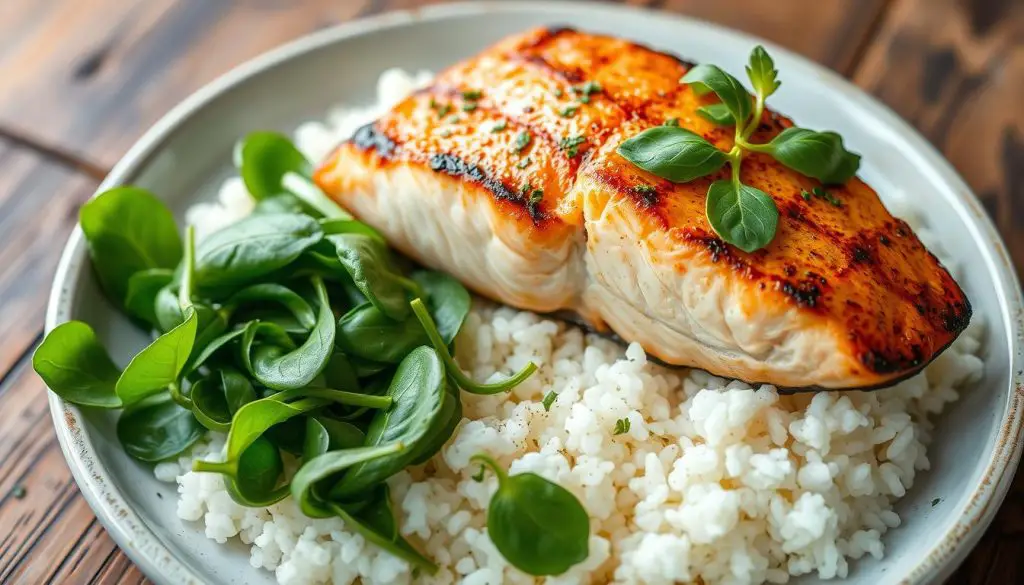
| Recipe Details | Value |
|---|---|
| Average Rating | 5 stars out of 113 reviews |
| Yield | 4-6 servings |
| Cooking Time | 15 minutes to bring to a boil, then an additional 10 minutes to steam |
| Recipe Categories | Appetizers + Sides, Dairy Free, Gluten Free, Lunch + Dinner, Vegan, Vegetarian |
Meal Preparation and Storage Tips
Keeping a healthy diet is key for managing fibromyalgia symptoms. But, meal prep can feel overwhelming. With some planning, you can make nutritious meals easy to enjoy all week. Here are some tips to help you start:
Batch Cooking for Efficiency
Batch cooking is a game-changer! Cook big batches of meals like grilled salmon with spinach and rice. This way, you have healthy meals ready in the fridge or freezer. It saves time and ensures you always have good food when you need it.
Repurpose Leftovers
Don’t waste leftover ingredients. Get creative and turn them into new dishes. For example, use leftover salmon and spinach in a salad or a frittata for breakfast.
Invest in Quality Storage Containers
Good food storage keeps your meals fresh and tasty. Get high-quality, leak-proof containers like glass or BPA-free plastic. This helps keep your food’s nutrients and flavors intact.
| Meal Preparation Tips | Food Storage Recommendations |
|---|---|
|
|
Follow these meal prep and storage tips to make healthy eating easier. Even on tough fibromyalgia days, you can stay on track.
Customizing the Recipe for Personal Preferences
This section offers tips for tweaking the grilled salmon with spinach and rice recipe. It’s designed for those with fibromyalgia. By making changes, you can enjoy a meal that fits your dietary needs and taste.
Adapting to Dietary Restrictions
Need to follow a gluten-free, dairy-free, or nut-free diet? No problem. Swap rice for quinoa or cauliflower rice for a gluten-free choice. Use coconut oil or olive oil instead of butter or cream. And, if you’re allergic to nuts, leave them out.
Adjusting Flavor Preferences
Do you like bold or mild flavors? You can tweak the seasoning to your liking. Add more garlic, lemon zest, or fresh herbs for a stronger taste. For a milder flavor, use less seasoning or try different herbs and spices.
Customizing this recipe is all about listening to your body and taste. Small changes can make a big difference. You’ll get a dish that’s good for you and delicious.
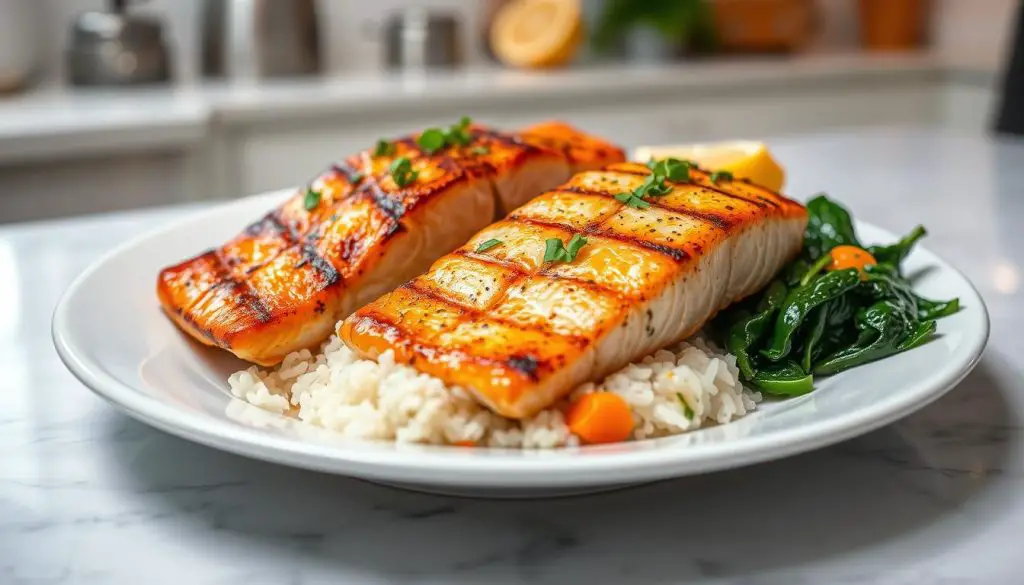
Incorporating More Anti-Inflammatory Foods
There’s more to fighting inflammation than just grilled salmon with spinach and rice. You can add many anti-inflammatory foods to your fibromyalgia diet. This can help manage your symptoms. By trying different foods, you can boost your health and feel better.
Here are some great anti-inflammatory foods to try:
- Fatty fish like salmon, tuna, sardines, and mackerel, which are rich in omega-3 fatty acids
- Dark, leafy greens such as spinach, kale, and collard greens, packed with vitamins, minerals, and antioxidants
- Berries like blueberries, raspberries, and strawberries, brimming with polyphenols
- Turmeric, ginger, and garlic, which contain potent anti-inflammatory compounds
- Nuts and seeds, including walnuts, almonds, and chia seeds, providing healthy fats and fiber
- Fermented foods like yogurt, kefir, and sauerkraut, which support gut health and immunity
Adding a variety of these anti-inflammatory foods to your diet can help you fight fibromyalgia symptoms. It’s all about nutrition.
| Anti-Inflammatory Food | Key Nutrients | Health Benefits |
|---|---|---|
| Salmon | Omega-3 fatty acids, vitamin D, protein | Reduces inflammation, supports heart and brain health |
| Spinach | Vitamins A, C, K, folate, magnesium, iron | Antioxidant and anti-inflammatory properties, supports bone and eye health |
| Blueberries | Antioxidants, fiber, vitamin C | Lowers inflammation, supports brain and heart health |
Managing Fibromyalgia Through Lifestyle Changes
Living with fibromyalgia can be tough, but making lifestyle changes can help. Diet is important, but so are exercise, stress management, and sleep. These changes can ease your symptoms and improve your life.
Exercise for Fibromyalgia Management
Exercise is key for fibromyalgia. Try walking, swimming, or gentle yoga to reduce pain and boost energy. Start slow and increase your workouts as you get stronger.
Stress Management Techniques
Stress can make fibromyalgia worse. Use meditation, deep breathing, or progressive muscle relaxation to relax. Enjoy activities like reading or listening to music to feel better.
Prioritizing Quality Sleep
Good sleep is vital for fibromyalgia patients. Stick to a sleep schedule, avoid screens before bed, and make your bedroom cozy. If sleep is hard, talk to a doctor for help.
By focusing on these lifestyle areas, you can manage your fibromyalgia better. Everyone is different, so try various approaches to find what works for you.
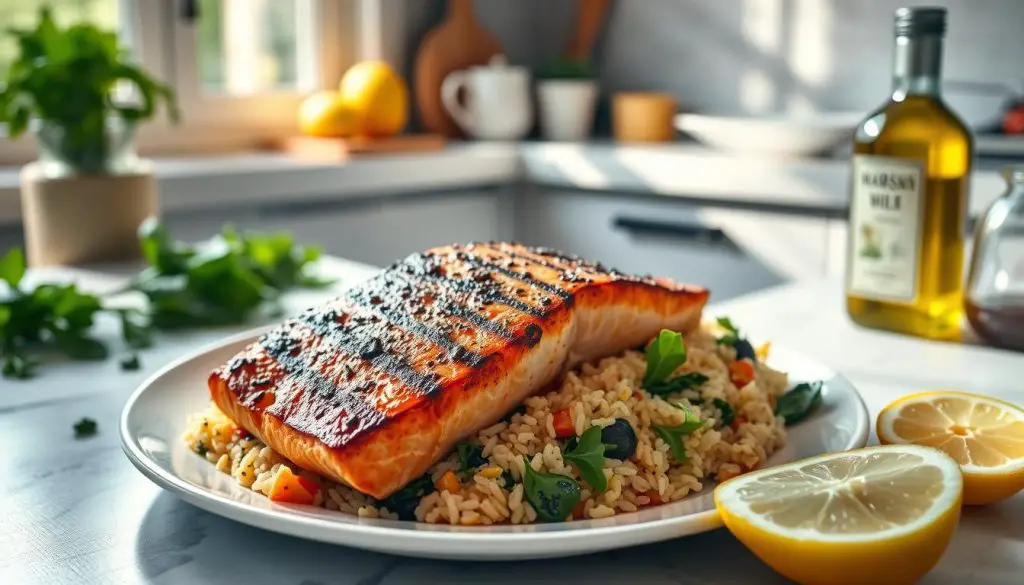
Seeking Professional Guidance
Managing fibromyalgia can be tough. Getting help from a registered dietitian or healthcare provider is key. They can help you create a diet plan that works for you.
A registered dietitian focused on fibromyalgia management can look at your diet needs. They’ll give you specific advice and help you make lasting changes. They also work with your healthcare provider to make sure your diet fits with your treatment.
Working with a professional can give you new insights. They can teach you about anti-inflammatory foods and how to avoid triggers. They’ll help you adjust your diet to improve your health.
There’s no single way to manage fibromyalgia. Getting professional guidance can lead you to the best diet plan for you. This can greatly improve your symptoms and life quality.
Sharing the Fibromyalgia-Friendly Recipe
Now that you’ve found the tasty grilled salmon with spinach and rice recipe, share it with your loved ones. This fibromyalgia-friendly meal can help spread the word about anti-inflammatory diets. These diets might help manage fibromyalgia symptoms.
Creating a supportive community is key for those with fibromyalgia. By sharing this recipe, you’re showing kindness and understanding. We can all help each other by choosing healthy, anti-inflammatory foods.
Encourage readers to share this delicious and nutritious recipe with friends and family members who may also benefit from an anti-inflammatory diet.
Source Links
- https://www.healthline.com/nutrition/fibromyalgia-diet-recipes
- https://www.eatingwell.com/article/7866119/rheumatoid-arthritis-diet-plan/
- https://fibromyalgia.zone/index.php?page=fibromyalgia-and-diet
- https://universityhealthnews.com/daily/pain/fibromyalgia-diet-may-help-control-pain/
- https://www.realsimple.com/food-recipes/recipe-collections-favorites/best-anti-inflammatory-recipes
- https://www.daniellewis.com.au/what-to-eat-for-an-anti-inflammatory-diet/
- https://www.eatingwell.com/article/291150/fibromyalgia-diet-foods-you-should-eat-and-foods-you-should-avoid/
- https://orthotoc.com/best-diet-for-fibromyalgia/
- https://www.verywellhealth.com/the-elimination-diet-for-fibromyalgia-cfs-715721
- https://www.lupus.org/resources/diet-and-nutrition-with-lupus
- https://www.healthline.com/nutrition/leaky-gut-diet
- https://coloradofibromyalgia.com/2021/04/22/10-fibromyalgia-diet-tips-reduce-pain-symptoms/
- https://www.medicalnewstoday.com/articles/321683
- https://gatherednutrition.com/anti-inflammatory-creamy-coconut-rice/
- https://my.clevelandclinic.org/departments/wellness/patient-resources/recipes
- https://www.chantalhoeysanders.com/chpt-2-controlling-symptoms-with-fo
- http://meljoulwan.com/2013/12/29/whole30-2014-week-1-meal-plan/
- https://www.healthline.com/health/multiple-sclerosis/tips-for-meal-prepping
- https://www.weightandwellness.com/resources/articles-and-videos/make-ahead-meal-snack-recipes
- https://www.healthline.com/health/crohns-disease/recipes
- https://bakingthebluesaway.wordpress.com/
- https://dhw.learningcenter.com/static/scorm/11/content/documents/DukeIM_PHPManual_fullversion_FINALwithcopyright.pdf
- https://theconsciouslife.com/top-10-inflammatory-foods-to-avoid.htm
- https://denverbackpainspecialists.com/mediterranean-diet/
- https://www.verywellhealth.com/leaky-gut-diet-4773680
- https://healingworksfoundation.org/resource/guide-to-nutrition-for-chronic-pain-what-you-eat-can-make-a-difference/
- https://med.stanford.edu/chronicfatiguesyndrome/patient-care.html
- http://ndl.ethernet.edu.et/bitstream/123456789/36842/1/3125.pdf
- https://southdenver.com/chronic-low-grade-inflammation-what-is-it-and-what-foods-can-help/
- https://livingwithfibromyalgia.org/fibromyalgia-friendly-recipes/
- https://www.healthline.com/nutrition/mind-diet
- https://www.medicalnewstoday.com/articles/323164
